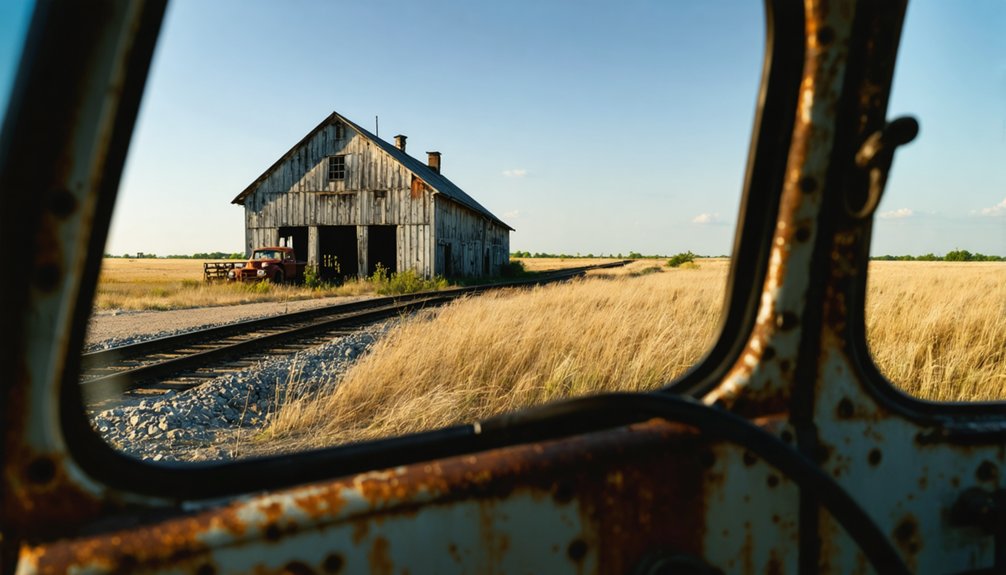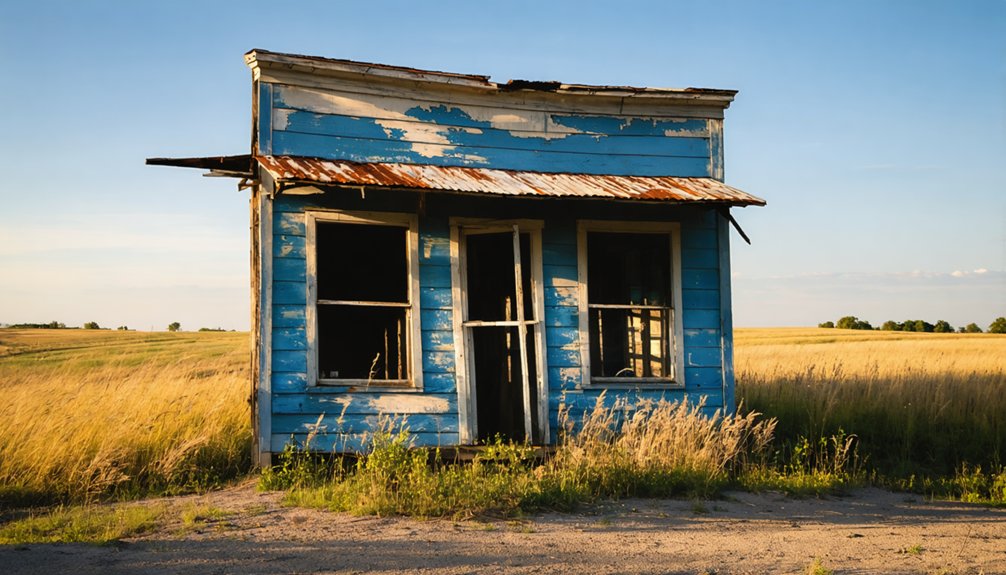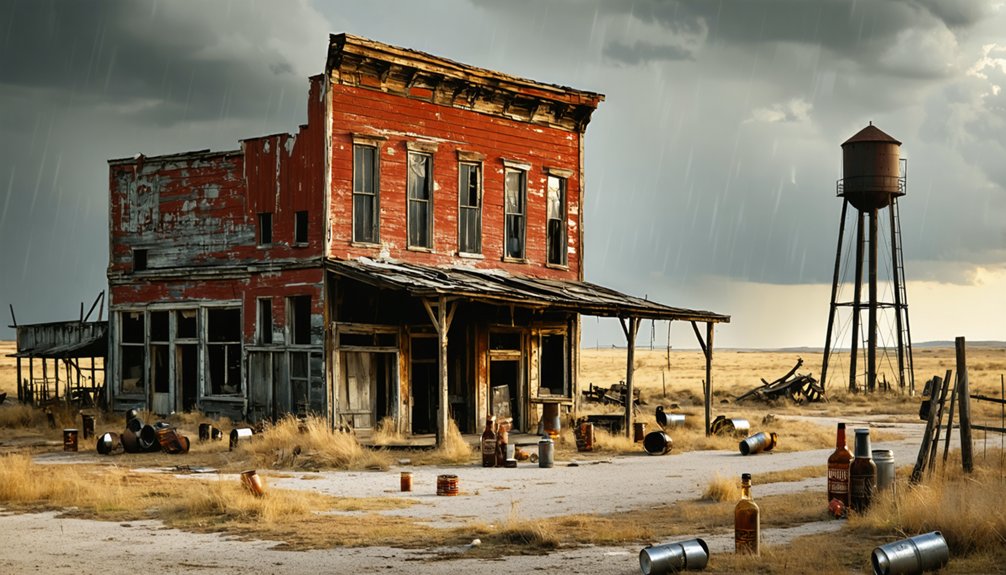You’ll find Carterville’s haunting ruins nestled in South Dakota’s Black Hills, where gold fever once drew thousands of prospectors in 1875. The settlement quickly evolved from a tent camp to a proper mining town, complete with supply stores, saloons, and a bustling railway depot. While the mines have long since closed and its younger residents departed after WWII, the scattered foundations and historical markers tell rich stories of frontier dreams and devastating economic forces that transformed this boomtown into a ghost town.
Key Takeaways
- Carterville emerged as a Black Hills mining settlement in 1879 near Deadwood Gulch during the regional gold rush.
- The town flourished with the arrival of railroads in 1885, featuring stores, saloons, and a strategic T-shaped commercial layout.
- Economic decline began after World War II when highways replaced railroads and mining operations closed.
- Severe agricultural challenges and bank failures between 2013-2018 accelerated the town’s transformation into a ghost town.
- Today, Carterville exists as ruins with historical markers and serves as an access point to the Mickelson Trail.
The Rise of a Black Hills Mining Settlement
While the exact origins of Carterville remain shrouded in the mists of Black Hills history, its establishment likely followed the pattern of many mining settlements that sprang up during the area’s 1875 gold rush.
You would’ve found the early prospectors setting up camp near gold-bearing creeks, essential for their sluicing operations and basic survival needs. Like other Black Hills settlements, Carterville’s mining technology evolved from simple panning to more sophisticated placer mining techniques.
Early prospectors followed the gold-bearing creeks, evolving their methods from basic panning to advanced placer mining as Carterville grew.
What started as a collection of tents would’ve gradually transformed into a more permanent settlement as miners struck promising deposits. Similar to the nearby Homestake Mine, which became America’s largest gold producer, local miners sought to exploit the region’s abundant ore deposits.
As word spread of the area’s potential, you’d have seen merchants, engineers, and fortune seekers flooding in, bringing with them the first hints of civilization – supply stores, boarding houses, and the eventual establishment of postal services. The settlement’s growth mirrored the broader pattern seen throughout the Black Hills, where treasure coaches became frequent targets for bandits transporting gold to larger cities.
Gold Rush Dreams and Early Development
You’ll find Carterville’s origins rooted in the Black Hills gold rush of 1879, when prospectors staked their claims amid the region’s promising creeks and mineral-rich hillsides.
The camp quickly attracted fortune seekers who’d learned from earlier rushes at Rockerville and other nearby settlements, where surface gold had already yielded impressive returns.
Like Rockerville which produced significant placer deposits, miners relied heavily on water-based extraction methods to access the valuable ore.
The discovery of the Homestake Mine nearby would soon overshadow many smaller operations in the region.
As the railroad pushed through the territory, you would’ve witnessed Carterville transform from a collection of tents and crude shelters into a proper mining settlement with increasingly permanent structures.
Mining Camp Origins 1879
As fortune seekers flooded the Black Hills in 1879, the mining camp of Carterville emerged near Deadwood Gulch with dreams of striking it rich.
You’d have found miners working their claims with basic mining techniques – rockers, sluices, and pure muscle power – as they extracted precious gold from both placer deposits and quartz veins.
The camp quickly grew into a bustling community of rough-hewn cabins and canvas tents, where supply stores and saloons catered to the daily needs of hardworking prospectors.
Life wasn’t easy, though – claim disputes often erupted between miners, while harsh living conditions and limited resources tested even the toughest souls.
Despite these challenges, Carterville’s strategic location and promising gold yields kept drawing adventurous spirits hoping to carve out their own piece of Black Hills prosperity.
Like nearby Central City, the settlement attracted diverse businesses and enterprises that helped transform it from a primitive camp into a more established town.
By 1880, the area saw a shift as lode mining operations gradually replaced the original placer mining methods.
Gold Prospectors Stake Claims
Thousands of enthusiastic prospectors descended upon the Carterville area in the late 1870s, staking claims along creek beds and gulches rich with placer gold deposits. You’d have found figures like Fred and Moses Manuel, Hank Harney, and Alex Engh among those who rushed to claim the most promising sites, including what would become the legendary Homestake vein.
Claim staking wasn’t without its challenges. You’d have witnessed countless legal disputes as overlapping claims and ownership conflicts erupted between individual prospectors. The Jenney expedition’s discovery in 1875 had initially sparked this rush of prospectors to the region.
By the mid-1870s, organized mining companies emerged to manage larger operations, though litigation remained common. The Hidden Treasure Mine exemplified these struggles, as legal disputes considerably delayed its production. The introduction of chlorination and smelting methods by 1890 revolutionized gold extraction in the region.
Despite the challenges, successful discoveries like those in Rockerville, which yielded $150,000 in its first year, kept prospectors’ dreams alive.
Railroad Fuels Town Growth
The arrival of railroads transformed Carterville from a scattered collection of mining claims into a bustling frontier town. When the Fremont, Elkhorn and Missouri Valley Railroad expanded into the Black Hills in 1885, you’d have witnessed an incredible surge of growth and prosperity. Local speculators actively invested in land parcels, anticipating lucrative returns from the railway’s expansion.
The railroad expansion brought new opportunities for miners and merchants alike, enabling them to ship ore and goods to distant markets with unprecedented speed. Following the common pattern of the era, the town adopted a T-shape layout with its main commercial avenue running perpendicular to the tracks.
- Town relocation became common as settlers rushed to establish themselves near the essential rail lines
- The depot emerged as Carterville’s communication and commerce hub
- Local grain elevators sprang up, connecting farmers to profitable urban markets
- The railway station became a social gathering place where you could catch up on news and gossip
Those iron rails didn’t just carry trains – they carried dreams of freedom and fortune across the Dakota Territory.
Daily Life in 1880s Carterville
Life in 1880s Carterville revolved around five central pillars: faith, education, culture, civic duty, and daily commerce.
The bedrock of 1880s small-town America rested upon timeless values that shaped both individual lives and community bonds.
You’d find yourself drawn to community gatherings at the local opera house or roller-skating rink, where traveling theater troupes performed and social bonds strengthened. Cultural expressions flourished through women’s coronet bands, literary societies, and glee clubs.
Your daily routine would’ve centered around wood-frame or log homes illuminated by kerosene lamps, while churches and schoolhouses stood as prominent landmarks.
You might’ve joined the Masons or Women’s Christian Temperance Union, attended formal balls, or participated in Arbor Day celebrations. Local businesses supported basic needs, while surrounding farms sustained the community.
Despite frontier challenges, you’d have found a vibrant social life through multiple venues and organizations.
Transportation and Economic Networks

As railroads carved through Dakota Territory in the late 19th century, you’d find Carterville strategically positioned along essential transportation corridors that shaped its economic destiny.
The town’s transportation infrastructure created significant links between local farmers and distant markets, fostering prosperity through efficient movement of goods and people.
- The rail station served as your community hub for mail, telegrams, and social gatherings.
- You’d see grain elevators and warehouses dotting the rail sidings, ready to store harvests.
- Local roads followed section lines, marked by stone mounds every quarter mile.
- Your neighbors contributed labor or taxes to maintain these important pathways.
The town’s fortunes shifted with post-WWII economic decline, as highways and trucks gradually replaced the once-mighty railroads that had been Carterville’s lifeblood.
This transformation ultimately contributed to the community’s gradual fade into ghost town status.
The Slow Fade Into Ghost Town Status
You’ll notice Carterville’s shift to ghost town status didn’t happen overnight, but rather through a steady exodus driven by the collapse of local mining operations and associated businesses.
The town’s younger residents relocated to urban areas seeking better opportunities, while the remaining population dwindled as essential services and businesses shuttered their doors.
What you’re seeing in Carterville’s gradual abandonment mirrors a common pattern in Black Hills mining communities, where economic forces triggered a decades-long spiral of declining population and deteriorating infrastructure.
Economic Forces Drive Exodus
Through relentless economic pressures in South Dakota’s agricultural sector, Carterville’s transformation into a ghost town unfolded with devastating predictability.
You’d have witnessed the heartbreaking cycle of economic challenges as net farm income plummeted 61% between 2013-2018, forcing many of your neighbors to abandon their family farms.
The rural migration accelerated as:
- Local banks failed, wiping out generations of savings
- Farm values crashed by up to 49%, leaving families underwater on loans
- Tax revenues plunged 25-50%, gutting essential services
- Weather disasters and low commodity prices crushed remaining farmers
The town’s lifeblood drained away as young farmers couldn’t enter the industry, while older ones liquidated their equity and left.
Each closed storefront and abandoned home marked another chapter in Carterville’s descent into emptiness.
Population Shrinks Over Decades
Three generations watched Carterville’s population steadily dwindle from its peak of 3,177 residents in 1930 to mere dozens today.
You’ll find similar population decline across South Dakota’s rural landscape, where aging residents remain while younger folks seek opportunities elsewhere. The signs of this exodus are everywhere – shuttered storefronts, empty homes, and quiet streets that once bustled with activity.
Like many rural communities, Carterville faces mounting challenges in maintaining basic services.
You’ll notice how limited access to healthcare, education, and jobs has accelerated the town’s transformation. While some isolated communities like Carter Township manage to sustain small but stable populations, Carterville’s story reflects a harder reality.
Each passing year brings fewer residents, as urban migration and economic shifts continue reshaping the rural heartland.
Legacy and Historical Remnants Today

Modern visitors to Carterville will find a ghost town that exists more in historical record than physical form, with its primary presence marked by the Kirk George S. Mickelson Trailhead.
While few original structures remain, the site’s historical markers remind you of its mining heritage, and today’s recreational use keeps the spirit of this frontier town alive through hikers and cyclists exploring the Black Hills.
- The town’s legacy lives on through its connection to the historic Homestake mining operations
- You’ll find scattered foundational ruins that hint at the once-thriving community
- The site serves as a representation of the boom-and-bust cycle of frontier mining towns
- The area has been repurposed as a recreational gateway to the Mickelson Trail system
Frequently Asked Questions
Are There Any Dangerous Abandoned Mine Shafts Near Carterville Today?
While you’ll find fascinating remnants of history, numerous dangerous abandoned mines scatter the area with severe safety concerns – unstable shafts, false floors, and toxic gases make exploration extremely risky.
What Notable Crimes or Incidents Occurred in Carterville During Its Peak?
You won’t find records of major Carterville crimes during its heyday. The town experienced typical mining disputes and petty theft, but unlike other Black Hills settlements, it stayed relatively peaceful.
Did Any Famous Historical Figures Ever Visit or Stay in Carterville?
Like searching for a needle in a ghost town haystack, you won’t find records of any famous historical visits or notable residents in this modest mining settlement’s documented past.
What Native American Tribes Lived in the Carterville Area Before Settlement?
You’ll find that Sioux tribes were the primary inhabitants, with their rich Lakota culture deeply rooted in the region. They lived freely across these lands, following seasonal patterns of hunting and gathering.
Are There Any Local Legends or Ghost Stories Associated With Carterville?
Like whispers in abandoned mine shafts, Carterville hauntings aren’t well documented, though you’ll hear local folklore about spectral miners and mysterious lights similar to other Black Hills ghost towns.
References
- https://www.sdpb.org/rural-life-and-history/2023-08-21/some-black-hills-ghost-towns-and-their-origins
- https://www.powderhouselodge.com/black-hills-attractions/fun-attractions/ghost-towns-of-western-south-dakota/
- https://www.sdhspress.com/journal/south-dakota-history-2-2/some-black-hills-ghost-towns-and-their-origins/vol-02-no-2-some-black-hills-ghost-towns-and-their-origins.pdf
- https://www.youtube.com/watch?v=_0WNYsFLSLA
- https://en.wikipedia.org/wiki/List_of_ghost_towns_in_South_Dakota
- https://westernmininghistory.com/towns/south-dakota/rockerville/
- https://www.blackhillshikingbikingandmore.com/old-mining-ghost-towns
- https://b1027.com/creepiest-coolest-ghost-towns-in-south-dakota-iowa-minnesota/
- https://en.wikipedia.org/wiki/Rockerville
- http://www.miningartifacts.org/South-Dakota-Mines.html



